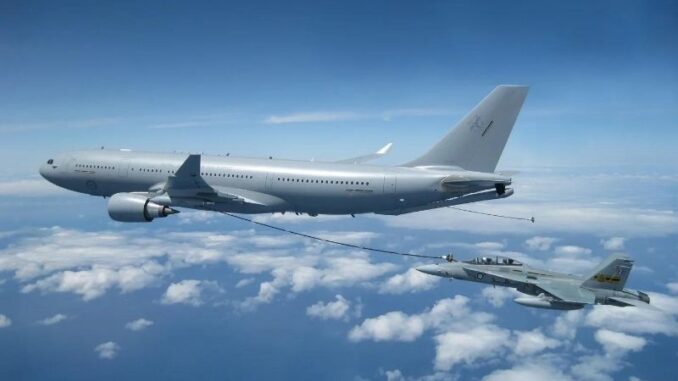
MANILA, Philippines — Dutch aerospace giant Airbus unveiled its latest military equipment offerings on Tuesday, September 24, which the Armed Forces of the Philippines (AFP) could potentially procure as part of its ongoing modernization program.
In a media briefing in Pasay City on Tuesday, September 24, the firm said that it is “well-placed” to support the expansion of the AFP in its modernization initiative on its “Horizon 3” phase as it eyes to expand its defense market in the Philippines.
“As the geopolitical landscape in the Asia Pacific region becomes more complex, it’s vital that nations like the Philippines are equipped with the tools to protect their sovereignty, particularly with the rising tensions in the South China Sea,” Jussi Hoikka, Airbus Chief representative for the Philippine said.
Hoikka disclosed that Airbus is currently in discussions with the Philippine Air Force, although he refrained from revealing specific details. The firm has proposed supplying the Philippine military with transport aircraft, helicopters and an air defense system.
Airbus has been the preferred brand of commercial airlines in the Philippines as most of their planes come from the Dutch aerospace firm.
Airbus is a prominent player in the Philippine aviation sector, with most commercial airlines sourcing their planes from the company. For instance, in July, Cebu Pacific signed a memorandum of understanding to purchase 152 Airbus aircraft worth $24 billion (P1.34 trillion).
On the military side, the Philippines has seven C295 medium-lift aircraft produced by the firm. Six of them are with the Philippine Air Force while the other one is with the 250th Presidential Air Wing.
Aircraft
Airbus offered three aircraft models for potential military procurement.
One of these is a retrofitted version of the C295, equipped with radar for surveillance missions. The firm also proposed the A330 Multi-Role Tanker Transport, which can serve both as a transport and refueling aircraft for multi-role fighter jets.
Airbus Media Centre via Adrian Molinos
A400M. Hoikka similarly noted the capabilities of the A400M heavy-lift aircraft, which could support resupply missions in the West Philippine Sea as it can be used for supply airdrops.
“The A400M’s ability to deliver oversized cargo directly to remote or austere locations is invaluable to the Philippines, particularly given its active role in global humanitarian efforts,” he said.
It can also be used as a refueling tanker for fighter aircraft while flying at the same time carrying military vehicles.
C-130. Aside from the C295 medium-lift aircraft, the Philippine Air Force operates four C-130 aircraft used for various missions.
In October 2023, the Department of National Defense approved the acquisition of three more C-130 planes, expected to arrive between July 2026 and January 2027.
However, unlike U.S. models, the Philippines’ C-130s are only used for troop and equipment transport, not for close air support.
Helicopters
Airbus also offered the H225M heavy-lift helicopter to meet the Philippine Air Force’s search-and-rescue and heavy-lift requirements.
“Combining long-range, all-weather capabilities with proven reliability and NATO certification, the H225M is a versatile, vital asset that would enhance the services’ abilities to respond swiftly and effectively to critical missions, while safeguarding national interests,” Hoikka said.
Hoikka noted the need for the Philippine Coast Guard to expand its helicopter fleet, which currently includes two H145 helicopters acquired in 2020.
“Obviously for an archipelagic nation like the Philippines, you can imagine that there are many bases around the country that would need such services… we hope to be able to support the expansion of that fleet,” he said.
Drones, air defense system
Airbus also showcased advanced surveillance and intelligence systems to aid the AFP.
These include the Fortion SuRVIn Suite for comprehensive air and maritime surveillance and the Fortion SkyControl for real-time intelligence integration, both designed to enhance situational awareness and decision-making.
In addition, Airbus’ FlexRotor Unmanned Aerial System (UAS) which can also be used for surveillance and reconnaissance missions.
“With over 3,700 combat flight hours, the FlexRotor is expected to bolster the capabilities of the Philippine Navy and Coast Guard in identifying and classifying maritime targets in complex environments,” Hoikka said.
Enhancing defense capabilities
The AFP Modernization Act, signed by former President Benigno Aquino III in 2012, aimed to modernize the Philippine military in three phases:
- Horizon 1, from 2013 to 2017
- Horizon 2, from 2018 to 2022
- Horizon 3, which began last year and will run until 2028
Last year, the Philippine military shifted its focus from internal security to territorial defense in response to the increasing aggression to China’s maritime assets in the West Philippine Sea.
In response, President Ferdinand Marcos Jr. approved the “Re-Horizon 3” initiative, which redefined the acquisition plan for the modernization’s third phase. Re-Horizon 3 will allocate up to $35 billion (P1.97 trillion) over the next decade.


Be the first to comment